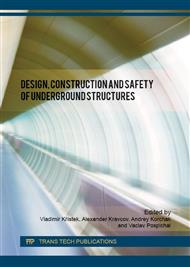p.65
p.72
p.81
p.87
p.93
p.103
p.111
p.118
p.125
Contact Laser-Ultrasonic Evaluation of Residual Stress
Abstract:
Investigation of residual stresses in an infrastructure is important due to the reason of safety. One of the most important problems is non-destructive testing of residual stresses particularly in welded constructions. A quite lot of technologies are used to solve this problem. Ultrasonic testing is based on the dependence of the velocity of ultrasonic waves on the stress value within a material under study. This technology is robust, operative and can be used in field conditions. The main problem is to measure the velocity of ultrasonic waves with high precision at a short trace. The proposed technique of the Contact Laser-Ultrasonic Evaluation (CLUE) is used in our work to overcome this difficulty. The variation of the results of the measurement of the ultrasonic wave velocity using CLUE does not exceed 0.05% and provides the threshold of the detection of the residual stress in steel at the level of 2-3 MPa. Basics of CLUE and some experimental cases of the study of the uniaxial stress in compressed and tensioned rail steel specimens are described. The advantages and disadvantages of CLUE for the stress measurement are discussed.
Info:
Periodical:
Pages:
118-124
Citation:
Online since:
July 2016
Price:
Сopyright:
© 2016 Trans Tech Publications Ltd. All Rights Reserved
Share:
Citation:


